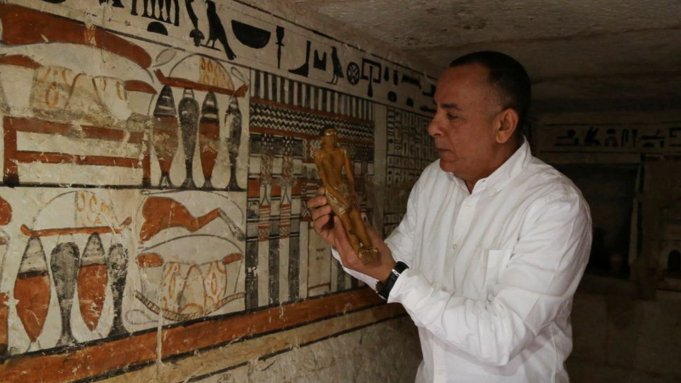Egypt uncovers the 4,000-year-old painted tomb of a royal palace official
Five painted tombs were recently unearthed in Saqqara, an ancient Egyptian necropolis just outside of Cairo, according to a report by Reuters.
The Egyptian Ministry of Tourism and Antiquities said that a recent excavation of burial shafts resulted in the finding of the tombs, along with more than 20 sarcophagi, toys, wooden boats, masks, and more.
The tombs are at least 4,000 years old, dating back to the Old Kingdom and First Intermediate period, a so called dark period in ancient Egyptian history as the regime of the Old Kingdom collapsed and political instability led to the destruction of monuments, artworks, and more. As such, not much remains from this time.

These tombs, however, are well-preserved and particularly well-decorated, with the additional inclusion of small statues and pots. Some of the paintings seem to represent food offerings.
The tombs, which reside near the pyramid of King Merenre I, are believed to have belonged to senior officials and court advisors.
The identity of two of those buried in the tombs has been ascertained. One was a top official named Iry, whose tomb included a limestone sarcophagus.
The other was occupied by a woman named Petty, who was both a priest of Hathor and a kind of beautician for Menere I.
Menere I is believed to be the father of Pepi II, the most notable pharaoh of this age whose reign is said to have lasted for more than 90 years.
The Egyptian government has been actively excavating Saqqara over the past several months.
In November, the Ministry of Tourism and Antiquities announced that it had found the tomb of a treasurer to the New Kingdom pharaoh Ramses II, which included several intact murals, in Saqqara.
These recent discoveries come amid the government’s “Follow the Sun” campaign that is aimed at attracting tourists to come see the archaeological wonders of ancient Egypt, both those well-known and recently discovered.
The country’s economy largely depends on this tourism, which has been impacted for over a decade beginning with the Arab Spring protests there.
More recently, the pandemic’s slowing down on international travel and Russia’s invasion of Ukraine—a large portion of tourists to Egypt are Polish, Russian, and Ukrainian—have also affected the tourism industry there.





